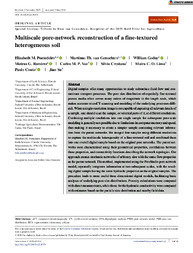Multiscale pore-network reconstruction of a fine-textured heterogeneous soil.
Multiscale pore-network reconstruction of a fine-textured heterogeneous soil.
Author(s): PONTEDEIRO, E. M.; GENUCHTEN, M. Th. van; GODOY, W.; VAZ, C. M. P.; CRESTANA, S.; LIMA, M. C. O.; COUTO, P.; SU, J.
Summary: Abstract Digital samples offer many opportunities to study subsurface fluid flow and contaminant transport processes. The pore size distribution of especially fine-textured porous media often covers many orders of magnitude in the length scale, which makes accurate microCT scanning and modeling of the underlying processes difficult. When a single-resolution image is not capable of capturing all relevant details of a sample, one should scan the sample, or selected parts of it, at different resolutions. Combining multiple resolutions into one single sample for subsequent pore-scale modeling is generally not possible due to limitations in computer memory and speed, thus making it necessary to create a simpler sample containing relevant information from the parent networks. We imaged four samples using different resolutions to capture the multiscale heterogeneity of a fine-textured soil and combined them into one overall digital sample based on the original pore networks. The parent networks were characterized using their geometrical properties, correlations between these properties, and connectivity functions describing the network topologies. Our approach creates stochastic networks of arbitrary size with the same flow properties as the parent network. The method, implemented using the PoreStudio pore network model, repeatedly integrates information at two subsequent scales, with the resulting digital sample having the same hydraulic properties as the original samples. The procedure leads to more useful three-dimensional digital models, facilitating basic analyses of underlying pore size distributions. Porosity calculations were compared with direct measurements, while those for the hydraulic conductivity were compared with estimates based on the particle size distribution and nearby field data.
Publication year: 2024
Types of publication: Journal article
Unit: Embrapa Instrumentation
Keywords: Fine-textured soil, PoreStudio
Observation
Some of Embrapa's publications are published as ePub files. To read them, use or download one of the following free software options to your computer or mobile device. Android: Google Play Books; IOS: iBooks; Windows and Linux: Calibre.
Access other publications
Access the Agricultural Research Database (BDPA) to consult Embrapa's full library collection and records.
Visit Embrapa Bookstore to purchase books and other publications sold by Embrapa.

